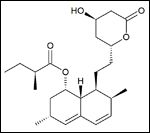Large Study Shows Statin use Lowers Incidence of Prostate Cancer
A large-scale, retrospective study published in the JNCI has now shown that men who take statins had lower incidence of total and high-grade prostate cancer compared with men who took antihypertensive medications.
Prostate cancer is one of the most commonly diagnosed cancers in the United States; 217,730 new cases of prostate cancer were diagnosed in 2010. However, while prostate cancer is frequently diagnosed, there are currently few known risk factors for the development of the disease, and few prevention approaches that doctors can recommend.

Structural formula of lovastatin
A large-scale, retrospective study published in the Journal of the National Cancer Institute has now shown that men who took statins had lower incidence of total and high-grade prostate cancer compared with men who took antihypertensive medications (doi: 10.1093/jnci/djr108). The impetus for the study was initial data that suggest that statins may be associated with a decreased chance of prostate cancer. Additionally, data suggest that men with low serum cholesterol levels also have a lower risk for prostate cancer.
The study authors used files provided by the Veterans Affairs New England Healthcare System to identify 55,875 men taking either a statin (41,078 men) or an antihypertensive drug (14,797 men). The study examined the correlation of statin use, lipid levels, and prostate cancer diagnosis, while attempting to correct for any potential cohort bias.
Men taking statins were 31% less likely to be diagnosed with prostate cancer (hazard ratio = 0.69). The statin cohort was 60% less likely to develop high-grade prostate cancer and 14% less likely to develop low-grade prostate cancer. Additionally, high levels of serum cholesterol were associated with higher risk for both high-grade and overall prostate cancer. Overall prostate cancer incidence was 1.3% in the antihypertensive cohort and 0.9% in the statin user cohort. The most frequently used statins were simvastatin (54.6%) and lovastatin (43.9%).
The authors believe that prospective clinical trials of statins for prostate cancer prevention are a reasonable next step to validate the results of this retrospective study.